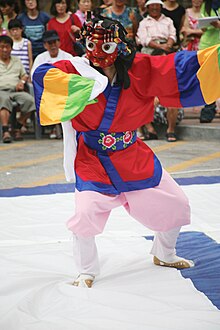Talchum
| Talchum | |
 |
|
| Korean name | |
|---|---|
| Hangul | 탈춤 |
| Hanja | none |
| Revised Romanization | talchum |
| McCune–Reischauer | t'alch'um |
Talchum or t'alch'um could be characterized as a Korean dance performed while wearing a mask, miming, speaking and even sometimes singing. Although the term talchum is usually taken to mean all mask dance dramas by most Koreans, it is strictly speaking a regional term originally only properly applied to dances of Hwanghae Province in present-day North Korea. Dances from the Seoul or Gyeonggi Province region are known as sandae noli, whereas the dances from the southern coast are known as yayu which means field play or ogwangdae which means dance of five clowns. However, Talchum is nowadays accepted as a general term for mask dance drama.
Korean mask dance dramas are not just dances performed by masked dancers but also include significant dramatic content with masked characters portraying people, animals and sometimes supernatural beings. These folk dramas reflect the frustrations felt by the lower classes towards the Confucian literati Yangban, due to the latter's treatment of the commoners, show the life of the common man and process social problems such as monks who ignore their precepts and men who cast off their old wives.
Talchum originated in Korean villages as part of shamanic rituals that had evolved to cleanse houses and villages, offer protection and good harvest. It then became a form of popular entertainment. It was once performed at the court – during the Koryo dynasty, the Office of Masked-Dance Drama (Sandae Togam) supervised such dances, and these dances may be performed at royal banquets. The office however was abolished during the Choson dynasty.
Mask dance dramas share fundamental characteristics, even though they vary considerably according to region and performer. Their basic themes are exorcism rites, ritual dances, biting satire, parody of human weaknesses, social evils and the privileged class. They appeal to the audiences by ridiculing apostate Buddhist monks, decadent upper classmen, and shamans. Another popular theme is the conflict between an old wife and a seductive concubine. With regional variations, the mask dance drama was generally performed on the First Full Moon, Buddha's Birthday on the Eighth of the Fourth Moon, Dano Festival and Chuseok. Variations may have been performed at festive state occasions or at rituals to supplicate for rain. The enthusiastic participation of the audience is the most remarkable feature of Korean mask dance drama. There is little distinction between the actors and the audience toward the end of a performance, as they join together in robust dance and bring it to a finale.
...
Wikipedia
